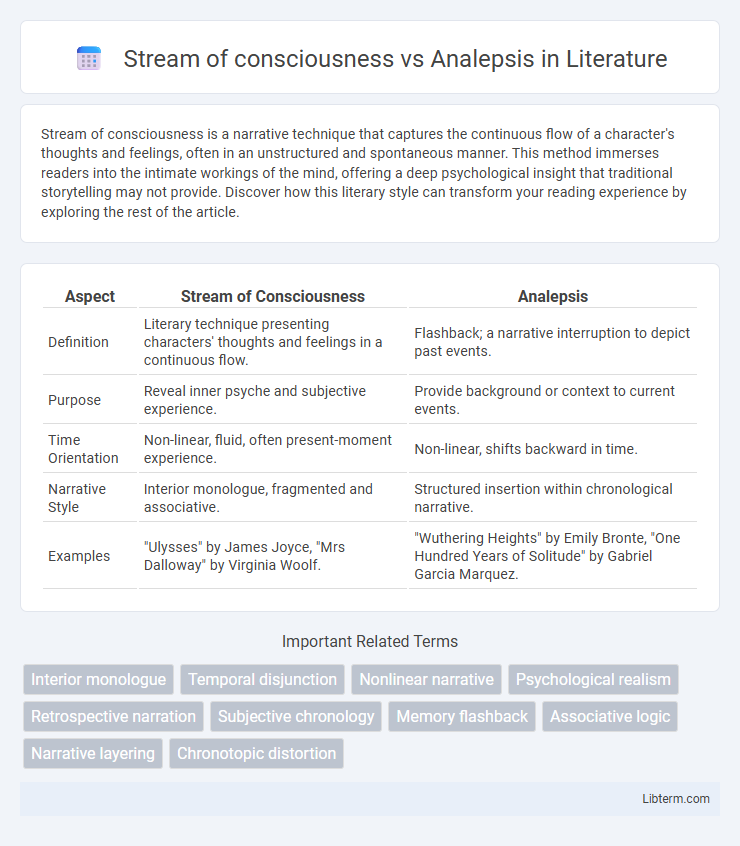Stream of consciousness is a narrative technique that captures the continuous flow of a character's thoughts and feelings, often in an unstructured and spontaneous manner. This method immerses readers into the intimate workings of the mind, offering a deep psychological insight that traditional storytelling may not provide. Discover how this literary style can transform your reading experience by exploring the rest of the article.
Table of Comparison
| Aspect | Stream of Consciousness | Analepsis |
|---|---|---|
| Definition | Literary technique presenting characters' thoughts and feelings in a continuous flow. | Flashback; a narrative interruption to depict past events. |
| Purpose | Reveal inner psyche and subjective experience. | Provide background or context to current events. |
| Time Orientation | Non-linear, fluid, often present-moment experience. | Non-linear, shifts backward in time. |
| Narrative Style | Interior monologue, fragmented and associative. | Structured insertion within chronological narrative. |
| Examples | "Ulysses" by James Joyce, "Mrs Dalloway" by Virginia Woolf. | "Wuthering Heights" by Emily Bronte, "One Hundred Years of Solitude" by Gabriel Garcia Marquez. |
Introduction to Narrative Techniques
Stream of consciousness immerses readers in a character's continuous flow of thoughts and feelings, capturing the subjective experience in real-time narrative. Analepsis, or flashback, interrupts chronological order by revisiting past events to provide context or reveal crucial backstory. Both techniques enhance narrative depth by exploring temporal shifts and inner psychology, enriching storytelling in literature and film.
Defining Stream of Consciousness
Stream of consciousness is a literary technique that aims to depict the continuous flow of a character's thoughts, feelings, and sensory experiences in an unstructured, often fragmented manner. It contrasts with analepsis, which involves a deliberate flashback or retrospective narration disrupting the chronological order of events. This method immerses readers directly into the protagonist's inner mind, creating a subjective reality distinct from traditional linear storytelling.
Understanding Analepsis (Flashback)
Analepsis, commonly known as flashback, is a narrative technique that interrupts the chronological flow of a story to revisit past events, providing critical context or background information. Unlike stream of consciousness, which delves into a character's internal thoughts and feelings in a continuous flow, analepsis externalizes memory by presenting discrete scenes from an earlier time. Mastery of analepsis allows writers to deepen character development, enhance plot complexity, and clarify motivations by revealing prior experiences that influence present actions.
Historical Origins and Evolution
Stream of consciousness originated in early 20th-century modernist literature, notably in the works of James Joyce and Virginia Woolf, as an innovative technique to depict the continuous flow of a character's thoughts and emotions. Analepsis, or flashback, traces back to classical Greek drama and ancient narratives, serving as a structural device to provide background information by interrupting the chronological flow. Over time, stream of consciousness evolved into a psychological exploration tool, while analepsis became integral for enhancing narrative depth and temporal complexity across various literary traditions.
Key Characteristics of Stream of Consciousness
Stream of consciousness is a narrative technique that presents a character's thoughts and feelings directly as they occur, often in a fragmented and nonlinear manner, reflecting the natural flow of the mind. It emphasizes interior monologue, spontaneous mental associations, and sensory impressions without structured syntax or chronological order. Unlike analepsis, which involves deliberate flashbacks to past events, stream of consciousness immerses readers in the subjective, continuous present experience of the character's psyche.
Essential Elements of Analepsis
Analepsis, or flashback, essential elements include a clear temporal shift, contextual clues such as verb tense changes, and integration within the narrative without disrupting flow. It provides background information by revisiting past events crucial to character development and plot progression. Unlike stream of consciousness, which captures a character's internal thoughts and feelings in real-time, analepsis structurally repositions past events to enhance understanding of the present narrative.
Literary Works Exemplifying Stream of Consciousness
Virginia Woolf's *Mrs. Dalloway* and James Joyce's *Ulysses* are seminal literary works that exemplify the stream of consciousness technique by delving into characters' inner thoughts and perceptions in a continuous flow. This narrative style contrasts with analepsis, or flashbacks, which interrupt the chronological sequence to revisit past events. Stream of consciousness prioritizes psychological depth and immediacy, immersing readers in the subjective experiences of the mind rather than external plot chronology.
Notable Uses of Analepsis in Literature
Analepsis, or flashback, is prominently used in literature to provide background and deepen character development, exemplified by Marcel Proust's "In Search of Lost Time," where vivid recollections shape the narrative's emotional depth. Another notable example is William Faulkner's "The Sound and the Fury," which employs analepsis to reveal complex timelines and perspectives within the Compson family saga. This technique contrasts with stream of consciousness by structuring past events explicitly rather than presenting unfiltered thoughts and perceptions in real-time.
Comparative Analysis: Stream of Consciousness vs Analepsis
Stream of consciousness and analepsis represent distinct narrative techniques with unique effects on storytelling. Stream of consciousness captures the continuous flow of a character's thoughts and feelings, providing an intimate, immersive experience; analepsis, or flashback, interrupts the chronological sequence to reveal past events, enriching context and character motivation. The former emphasizes internal subjectivity and immediacy, while the latter enhances narrative depth by integrating temporal shifts and background insights.
Impact on Reader Experience and Storytelling
Stream of consciousness immerses readers directly into a character's unfiltered thoughts and emotions, creating an intimate and often fragmented narrative that enhances emotional depth and psychological realism. Analepsis, or flashback, provides structured background information that clarifies motives and context, enriching plot comprehension without disrupting the linear progression excessively. The use of stream of consciousness often intensifies subjective engagement, while analepsis offers strategic retrospection, both shaping the reader's understanding and emotional connection in distinct yet complementary ways.
Stream of consciousness Infographic

 libterm.com
libterm.com